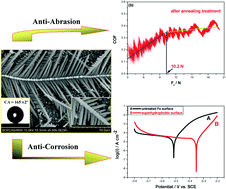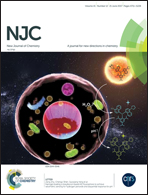Fabrication of Cu–CuO–Fe2O3/Fe anti-sticky and superhydrophobic surfaces on an iron substrate with mechanical abrasion resistance and corrosion resistance†
Abstract
Herein, Cu–CuO–Fe2O3/Fe superhydrophobic surfaces (SHSs) were successfully fabricated on an iron substrate via chemical substitution deposition and subsequent annealing treatment. The resulting surfaces exhibit remarkable superhydrophobicity with a water CA of 165 ± 2° and an SA of approximately 0° without any organic modification. The surface morphology and chemical compositions were investigated using field emission scanning electron microscopy (FESEM), energy dispersive spectroscopy (EDS), X-ray powder diffraction (XRD), and X-ray photoelectron spectroscopy (XPS); moreover, the surface roughness was analyzed via atomic force microscopy (AFM). The thermal treatment, which caused generation of a new chemical substance and formation of micro-/nano-binary architectures, was important for superhydrophobicity and also enhanced the affinity of the iron substrate for the coatings. The annealing temperature and time were further investigated to explain the significance of the surface morphology and chemical composition in the fabrication of the optimal SH samples under appropriate conditions. The resulting SHSs exhibit roll-down, anti-abrasion, and anti-corrosion properties, which may have significant potential value for more applications.



 Please wait while we load your content...
Please wait while we load your content...